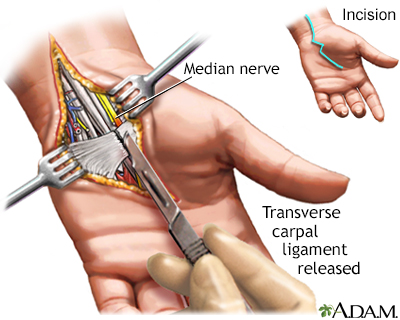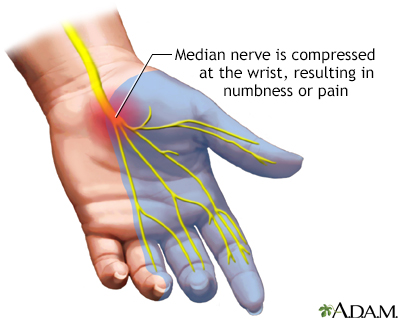Carpal tunnel syndrome
Carpal tunnel syndrome is a condition in which there is excessive pressure on the median nerve at the wrist. This is the nerve that allows feeling and movement to parts of the hand. Carpal tunnel syndrome can lead to pain, numbness, tingling, weakness, or muscle damage in the hand and fingers.
Carpal tunnel syndrome - Animation
Typing all day on a computer keyboard can be tough on your wrists. If you type for hours at a time, day after day, eventually you may really start to feel some discomfort. The numbness, pain, and tingling you feel in your hands and wrists may be carpal tunnel syndrome, and it can have such a big effect on your life that you may eventually need surgery to treat it. Doing any repetitive motion with your hands, whether it's typing, sewing, driving, or writing, can cause carpal tunnel syndrome. The condition gets its name from an area in your wrist called the carpal tunnel. Running through this tunnel is the median nerve, which sends feeling to your palm and most of your fingers. When you do the same task over and over again, especially flexing and extending the wrist, you put pressure on the median nerve. Over time, it swells up inside the carpal tunnel until it's so tight in there that the nerve gets pinched. The classic symptoms of carpal tunnel syndrome are numbness and tingling in your hand, including the thumb, index, middle, and half of the ring finger. The discomfort is usually worse at night. And anytime you may not be able to grip things as tightly in the affected hand, and you can feel pain that may stretch all the way from the wrist to your elbow. Your doctor can run tests on your hand to confirm that your numbness, weakness, and pain are due to carpal tunnel. You may also have nerve conduction studies, or tests of the muscles. If you're feeling a lot of discomfort from carpal tunnel wearing a wrist splint especially at night could help. In addition, short term oral or injected glucocorticoid medications can help by reducing swelling. Studies have also shown some benefit from physical or occupational therapy techniques, and yoga. About half of the people with carpal tunnel though will eventually need a procedure called carpal tunnel release to lift pressure off the pinched nerve. Surgery is a more permanent solution, but whether it works depends on how severe the nerve damage is, and how long you've had it. You may not be able to completely avoid the repetitive flexing or extending the wrist that gave you carpal tunnel in the first place, especially if it's part of your job. But, you can make some adjustments, for example, by using special devices like a cushioned mouse pad, wrist braces, or a raised keyboard, to relieve the pressure on your wrists. Take occasional breaks whenever you're going to be typing or doing any other repetitive task for long periods of time. And if you are having any numbness, tingling, or pain in your hands or wrists, see your doctor sooner rather than later. Letting carpal tunnel syndrome go untreated could leave you with a permanently damaged nerve.
Causes
The median nerve typically provides feeling and movement to the thumb side of the hand. This includes the palm, thumb, index finger, middle finger, and thumb side of the ring finger.
The area in your wrist where the nerve enters the hand is called the carpal tunnel. This tunnel is normally narrow. A thick ligament (tissue) just under your skin (the carpal ligament) makes up the top of this tunnel. Any swelling can pinch the nerve and cause pain, numbness, tingling, or weakness. This is called carpal tunnel syndrome.

Compression of the median nerve
A diagnosis of carpal tunnel syndrome may follow testing the affected hand for numbness, tingling, weakness and/or pain in specific areas. Muscle and nerve conduction tests may also help affirm or rule out carpal tunnel syndrome.
Some people who develop carpal tunnel syndrome were born with a small carpal tunnel.
Carpal tunnel syndrome can also be caused by making the same hand and wrist motion over and over. Using hand tools that vibrate may also lead to carpal tunnel syndrome.

Surface anatomy - normal wrist
This picture shows a normal flexed hand. The tendons that move the fingers and are associated with carpal tunnel syndrome are visible just below the wrist.
Studies have not proved that carpal tunnel is caused by typing on a computer, using a mouse, or repeating movements while working, playing a musical instrument, or playing sports. But, these activities may cause tendinitis or bursitis in the hand, which can narrow the carpal tunnel and lead to symptoms.
Carpal tunnel syndrome occurs most often in people ages 30 to 60. It is more common in women than men.
Other factors that may lead to carpal tunnel syndrome include:
- Alcohol use
Alcohol use
Alcohol use disorder is when your drinking causes serious problems in your life, yet you keep drinking. You may also need more and more alcohol to f...
 ImageRead Article Now Book Mark Article
ImageRead Article Now Book Mark Article - Bone fractures and arthritis of the wrist
Bone fractures
If more pressure is put on a bone than it can stand, it will split or break. A break of any size is called a fracture. If the broken bone punctures...
 ImageRead Article Now Book Mark Article
ImageRead Article Now Book Mark Article - Cyst or tumor that grows in the wrist
Cyst
A cyst is a closed pocket or pouch of tissue. It can be filled with air, fluid, pus, or other material.
 ImageRead Article Now Book Mark Article
ImageRead Article Now Book Mark Article - Infections
- Obesity
Obesity
Overweight and obesity mean having a weight than is higher than what is healthy for a given height. A person may be overweight from extra muscle, bo...
 ImageRead Article Now Book Mark Article
ImageRead Article Now Book Mark Article - Extra fluids retained during pregnancy or menopause
Menopause
Menopause is the time in a woman's life when her periods (menstruation) stop. Most often, it is a natural, normal body change that occurs between ag...
 ImageRead Article Now Book Mark Article
ImageRead Article Now Book Mark Article - Rheumatoid arthritis
Rheumatoid arthritis
Rheumatoid arthritis (RA) is a disease that leads to inflammation of the joints and surrounding tissues. It is a long-term disease. It can also aff...
 ImageRead Article Now Book Mark Article
ImageRead Article Now Book Mark Article - Diseases that have abnormal deposits of protein in the body (amyloidosis)
Amyloidosis
Primary amyloidosis is a rare disorder in which abnormal proteins build up in tissues and organs. Clumps of the abnormal proteins are called amyloid...
 ImageRead Article Now Book Mark Article
ImageRead Article Now Book Mark Article
Symptoms
Symptoms may include any of the following:
- Clumsiness of the hand when gripping objects
- Numbness or tingling or tingling in the thumb and next two or three fingers of one or both hands
Numbness or tingling
Numbness and tingling are abnormal sensations that can occur anywhere in your body, but they are often felt in your fingers, hands, feet, arms, or le...
 ImageRead Article Now Book Mark Article
ImageRead Article Now Book Mark Article - Numbness or tingling of the palm of the hand
- Pain that extends to the elbow
- Pain in the wrist or hand in one or both hands
- Problems with fine finger movements (coordination) in one or both hands
- Wasting away of the muscle under the thumb (in advanced or long-term cases)
- Weak grip or difficulty carrying bags (a common complaint)
- Weakness in one or both hands
Exams and Tests
During a physical exam, your health care provider may find:
- Numbness in the palm, thumb, index finger, middle finger, and thumb side of your ring finger (some people have variations in the location of numbness)
- Weak hand grip
- Tapping over the median nerve at your wrist may cause pain to shoot from your wrist to your hand (this is called the Tinel sign)
- Bending your wrist forward all the way for 60 seconds will usually result in numbness, tingling, or weakness (this is called the Phalen test)
- Difficulty in identifying two points along the fingers
Tests that may be ordered include:
- Wrist x-rays to check for other problems, such as arthritis in your wrist
Wrist x-rays
This test is an x-ray of a knee, shoulder, hip, wrist, ankle, or other joint.
 ImageRead Article Now Book Mark Article
ImageRead Article Now Book Mark Article - Electromyography (EMG, a test to check muscles and the nerves that control them)
Electromyography
Electromyography (EMG) is a test that checks the health of the muscles and the nerves that control the muscles.
 ImageRead Article Now Book Mark Article
ImageRead Article Now Book Mark Article - Nerve conduction velocity (a test to see how fast electrical signals move through a nerve)
Nerve conduction velocity
Nerve conduction velocity (NCV) is a test to see how fast electrical signals move through a nerve. This test is done along with electromyography (EM...
 ImageRead Article Now Book Mark Article
ImageRead Article Now Book Mark Article
Treatment
Your provider may suggest that you:
- Wear a splint at night for several weeks. If this does not help, you may need to wear the splint during the day as well.
- Avoid sleeping on your wrists.
- Place warm and cold compresses on the affected area.
Changes you can make in your workplace to reduce the stress on your wrist include:
- Using special devices, such as keyboards, different types of computer mouse, cushioned mouse pads, and keyboard drawers.
- Having someone review the position you are in when performing your work activities. For example, make sure the keyboard is low enough so that your wrists are not bent upward while typing. Your provider may suggest an occupational therapist.
- Making changes in your work duties or home and sports activities. Some of the jobs linked with carpal tunnel syndrome include those that involve vibrating tools.
MEDICINES
Medicines used to treat carpal tunnel syndrome include nonsteroidal anti-inflammatory drugs (NSAIDs), such as ibuprofen or naproxen. Corticosteroid injections can be given into the carpal tunnel area to relieve symptoms.
SURGERY
Carpal tunnel release is a surgical procedure that cuts into the ligament that is pressing on the nerve. Surgery is successful most of the time but depends on how long you've had the nerve compression and its severity.
Carpal tunnel release
Carpal tunnel release is surgery to treat carpal tunnel syndrome. Carpal tunnel syndrome is pain and weakness in the hand that is caused by pressure...


Carpal tunnel surgical procedure
In treating carpal tunnel syndrome, surgery may be required to release the compressed median nerve. The open release procedure involves simply cutting the transverse carpal ligament.
Outlook (Prognosis)
Symptoms often improve without surgery. But more than one half of cases eventually need surgery. Even if surgery is successful, full healing can take months.
Possible Complications
If the condition is treated properly, there are usually no complications. If untreated, the nerve can be damaged, causing permanent weakness, numbness, and tingling.
When to Contact a Medical Professional
Contact your provider for an appointment if:
- You have symptoms of carpal tunnel syndrome
- Your symptoms do not respond to regular treatment, such as rest and anti-inflammatory drugs, or if there seems to be a loss of muscle bulk around your fingers
- Your fingers lose more and more feeling
- You are dropping things and becoming more clumsy with your hand
Prevention
Use tools and equipment that are properly designed to reduce the risk for wrist injury.
Ergonomic aids, such as split keyboards, keyboard trays, typing pads, and wrist braces, may be used to improve wrist posture during typing. Take frequent breaks when typing and always stop if you feel tingling or pain.
Reviewed By
C. Benjamin Ma, MD, Professor, Chief, Sports Medicine and Shoulder Service, UCSF Department of Orthopaedic Surgery, San Francisco, CA. Also reviewed by David C. Dugdale, MD, Medical Director, Brenda Conaway, Editorial Director, and the A.D.A.M. Editorial team.
Weller WJ, Calandruccio JH, Jobe MT. Compressive neuropathies of the hand, forearm, and elbow. In: Azar FM, Beaty JH, eds. Campbell's Operative Orthopaedics. 14th ed. Philadelphia, PA: Elsevier; 2021:chap 77.
Zhao M, Burke DT. Median neuropathy (carpal tunnel syndrome). In: Frontera WR, Silver JK, Rizzo TD Jr, eds. Essentials of Physical Medicine and Rehabilitation: Musculoskeletal Disorders, Pain, and Rehabilitation. 4th ed. Philadelphia, PA: Elsevier; 2019:chap 36.



 All rights reserved.
All rights reserved.